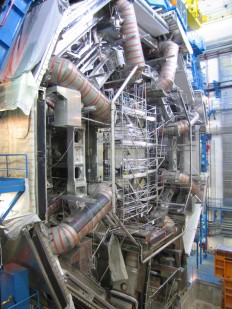
ATLAS under construction, Source
On July 13th, UC Berkeley physicists, including Professors Beate Heinemann and Marjorie Shapiro – collaborators in the ATLAS experiment, explained the discovery of what could be the Higgs Boson. Their explanation of the decades long search for the Higgs Boson serves as an interesting comparison to Buddhist practice – not as a comparison of ultimate claims about the nature of reality, but a comparison of deep and prolonged investigations in subtle, invisible fields. This deep and prolonged investigation is at the heart of Buddhism as a personal practice, in contrast to Buddhism as a set of philosophical or religious assertions.
One of the vexing problems in quantum physics has been that the standard model used by quantum physics can explain forces like light and magnetism, as well as short range fields that exist at the atomic and subatomic level. But common everyday phenomena like gravity and mass have no explanation in quantum physics. Quantum physics, a physics of invisibly small particles and intangible fields, is still trying to explain these everyday phenomena.
Half a century ago, theoretical physicists proposed a theory that mass is the consequence of a field that permeates all of space, even the emptiness of a pure vacuum.
Half a century ago, theoretical physicists proposed a theory that mass is the consequence of a field that permeates all of space, even the emptiness of a pure vacuum. In quantum physics, fields have manifestations as particles and vice versa. Today, we call this field the Higgs Field and the corresponding particle the Higgs Boson. If the theory were correct, then it would be possible to have the Higgs field produce a Higgs Boson. In the interim, many other theories have been proposed, some of which have been described as “more beautiful” than the Higgs theory. The search for the Higgs Boson is an attempt to discover which theory (of many) most accurately describes the world around us.
The new experiments show that a vacuum is not genuinely empty, but consists of protons with a very short lifespan. When the protons smash into each other, they unleash things that are latent in the not-really-empty-vacuum. Similarly, my experiences from moment to moment are also not empty, but consist of dharmas and the latent tendencies embedded in saṃskāras. Whereas space is permeated by an invisible, all permeating field, my awareness takes into account subtle energies that have accumulated over time. In meditation, I apply tremendous effort to observe the unconscious processes that underlie mental activities.
Similarly, my experiences from moment to moment are also not empty, but consist of dharmas and the latent tendencies embedded in saṃskāras.
Initially, scientists had no idea even what to look for, but they were determined to sort out the competing theories and pursue the investigation, even in the face of uncertainty. This shows faith in the process and method of investigation, not faith in a particular theory or set of assertions. In fact, the more elegant and “beautiful” theories turned out to be disproved by the latest evidence, proving that scientists could not rest on a theory that merely seemed to be elegant. Instead, theories have to be verified by evidence.
This goes to show that true wisdom is not about a particular set of philosophical assertions or fixed views, but about the moment to moment discernment that continues to be sharpened by the constant and prolonged exercise of personal investigation. Because of this, cultivators stand to learn from how the physicists have pursued the search for the Higgs Boson. Scientists are not content with an elegant theory that has the “ring of truth.” They are not content to accept the authority of various prominent physicists and are not willing to quit even when it is not clear what they are supposed to be looking for. Even now that it looks like the Higgs has been found, there is even more to investigate and many competing theories are being formulated, even after some have been ruled out. Across different spiritual traditions and even within Buddhism, there are many theories as well, which serve as topics for investigation, not as ultimate truths to which one must adhere. And as with the particle accelerators of modern physics, the deepest claims cannot be investigated without a large investment of time and energy.
